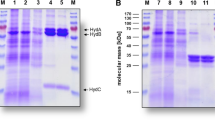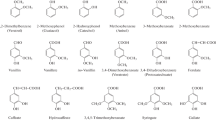Abstract
Formation of alcohols by natural processes takes place in the fermentative breakdown of sugars and the oxidative dissimilation of alkanes. In view of the wide-spreadness of these processes, it is understandable that many microbial species have the capacity to degrade these compounds. Formaldehyde takes a prominent position among the aldehydes found in Nature. The reason is the frequent occurrance of natural (e.g. methylated amines) as well as man-made C1-compounds (industrial solvents like DMSO and DMF are used at large scale as well as methylated and methoxylated bulk chemicals, leading to contamination of the environment with these compounds) which are degraded via formaldehyde by a variety of C1-compounds-utilizing microbes, the so-called methylotrophs. However, also adventitious formaldehyde formation takes place, e.g. in organisms using methylated amines as a nitrogen source or in organisms using pectins, the degradation process liberating methanol from the esterified groups which can be converted to formaldehyde by alcohol oxidizing enzymes. Since formaldehyde is a toxic compound but the ability to assimilate it is confined to methylotrophs, it is obvious that most micro-organisms have developed an oxidative system to get rid of this compound.
Access this chapter
Tax calculation will be finalised at checkout
Purchases are for personal use only
Preview
Unable to display preview. Download preview PDF.
Similar content being viewed by others
References
Allen, S.H.G., 1982, Lactate-oxaloacetate transhydrogenase from Veillonella alcalescens, Methods Enzymol. 89: 367.
Ameyama, M., and Adachi, O., 1982, Alcohol dehydrogenase from acetic acid bacteria, membrane bound, Methods Enzymol. 89: 450.
Anthony, C., 1992, The structure of bacterial quinoprotein dehydrogenases, Int. J. Biochem. 24: 29.
Arfman, N., Van Beeumen, J., De Vries, G.E., Harder, W., and Dijkhuizen, L., 1991, Purification and characterization of an activator protein for methanol dehydrogenase from thermotolerant Bacillus spp., J. Biol. Chem. 266: 3955.
Bystrykh, L.V., Dijkhuizen, L., and Harder, W., 1991, Modification of flavin adenine dinucleotide in alcohol oxidase of the yeast Hansenula polymorpha, J. Gen. Microbiol. 137: 2381.
Caspritz, G. and Radler, F., 1983, Malolactic enzyme of Lactobacillus plantarum. J. Biol. Chem. 258: 4907.
Chalmers, R.M. Keen, J.N., and Fewson, C.A., 1991, Comparison of benzylalcohol dehydrogenase and benzaldehyde dehydrogenases from Acinetobacter calcoaceticus and from Pseudomonas putida, Biochem. J. 273: 99.
Cox, R.B., and Quayle, J.R., 1975, The autotrophic growth of Micrococcus denitrificans on methanol, Biochem. J. 150: 569.
De Vries, G.E., Arfman, N., Terpstra, P., and Dijkhuizen, L., 1992, Cloning, expression and sequence analysis of the methanol dehydrogenase gene from Bacillus sp. strain C1, J. Bacteriol, 174: 5346.
Dickinson, F.M., and Wadforth, C., 1992, Purification and some properties of alcohol oxidase from alkane-grown Candida tropicalis, Biochem. J. 282: 325.
Duine, J.A., Frank, J., and Berkhout, M.P.J., 1984, NAD-dependent PQQ-containing methanol dehydrogenase: a bacterial dehydrogenase in a multi-enzyme complex, FEBS Lett. 168: 217.
Duine, J.A., 1991, Quinoproteins: enzymes containing the quinonoid cofactor pyrroloquinoline quinone (PQQ), topaquinone (TPQ) or tryptophanyl tryptophan quinone (TTQ), Eur. J. Biochem. 200: 271.
Duine, J.A., Van Dijken, J.P., 1991, Enzymes of industrial potential in methylotrophs, in: “Biology of Methylotrophs,” J. Goldberg, and J.S. Rokem, eds., Butterworth-Heinemann, Boston, p. 233.
Fahey, R.C., and Newton, G.L., 1983, Occurence of low molecular weight thiols in biological systems, in: “Functions of glutathione,“ A. Larsson et al., ed., Raven Press, New York, p. 251.
Frey, P.A., 1987, Complex pyridine nucleotide-dependent transformations, in: “Pyridine nucleotide coenzymes,” D. Dolphin et al., ed., John Wiley & Sons, New York.
Geerlof, A., Van Tol, J.B.A., Jongejan, J.A., and Duine J.A., 1992, Microbial alcohol/aldehyde oxidoreductases in enantioselective conversion, in: “Microbial Reagents in Organic Synthesis,” S. Servi, ed., Kluwer Acad. Publ., Dordrecht, in press
Groeneveld, A., Dijkstra, M. and Duine, J.A, 1984, Cyclopropanol in the exploration of bacterial alcohol oxidation, FEMS Microbiol Lett. 25: 311.
Gutheil, W.G., Holmquist, B., and Vallee, B.L., 1992, Purification, characterization, and partial sequence of the glutathione-dependent formaldehyde dehydrogenase from Escherichia coli, Biochemistry 31: 475.
Heim R., and Strehler, E.E., 1991, Cloning an Escherichia coli gene encoding a protein remarkably similar to mammalian aldehyde dehydrogenases, Gene 99: 15.
Inoue, T., Sunagawa, M., Mori, A., Imai, C., Fukuda, M, Takagi, M, and Yano, K., 1990, Possible functional domains in a quinoprotein alcohol dehydrogenase from Acetobacter aceti, J. Ferm. Bioeng. 70: 58.
Jörnvall, H., Persson, B., and Jeffery, J., 1987, Characteristics of alcohol/polyol dehydrogenases, Eur. J. Biochem. 167: 195.
Kato, N., Yamagami, T., Shimao, M., and Sakazawa, C., 1986, Formaldehyde dismutase, a novel NAD-binding oxidoreductase from Pseudomonas putida F61, Eur. J. Biochem. 156: 59.
Kirkman, H.N., and Gaetani, C.F., 1984, Catalase: a tetrameric enzyme with four tightly bound molecules of NADPH, Proc. Natl. Acad. Sci. 81: 4343.
Kok, M., Oldenhuis, R., Van der Linden, M., Meulenberg, C.H.C., Kingma, J., and Witholt, B., 1989, The Pseudomonas oleovorans alk BAC Operon encodes two structurally related rubredoxins and an aldehyde dehydrogenase, J. Biol. Chem., 264: 5442.
Koivusalo, M., Baumann, M., and Uotila, L., 1989, Evidence for the identity of glutathione-dependent formaldehyde dehydrogenase and class III alcohol dehydrogenase, FEBS Lett. 257: 105.
Ledeboer, A.M., Edens, L., Maat, J., Visser, G., Bos, J.W., Verrips, C.T., Janowicz, Z., Eckart, M. and Hollenberg, C.P., 1985, Molecular cloning and characterization of a gene coding for methanol oxidase in Hansenula potymorpha, Nucleic Acids Res. 13: 3063.
Long, A.R., and Anthony, C., 1990, Modifier protein for methanol dehydrogenase of methylotrophs, Methods Enzymol. 188: 216.
Mason, R.P., and Sanders, J.K.M., 1989, In vivo enzymology: a deuterium NMR study of formaldehyde dismutase in Pseudomonas putida F61a and Staphylococcus aureus, Biochemistry 28: 2160.
Mukund, S., and Adams, M.W.W., 1991, The novel tungsten-iron-sulfur protein of the hyperthermophilic archaebacterium Pyrococcus furiosis, is an aldehyde ferredoxin oxidoreductase, J. Biol. Chem. 266: 14208.
Ogushi, S., Ando, M., and Tsuru, D., 1984, Substrate specificity of formaldehyde dehydrogenase from Pseudomonas putida, Agric. Biol. Chem. 48: 597.
Ogushi, S., Ando, M. and Tsuru, D., 1986, Formaldehyde dehydrogenase from Pseudomonas putida: the role of a cysteinyl residue in the enzyme activity, Agric. Biol. Chem. 50: 2503.
Patel, R.N., Hou, C.T., Derelanko, P., and Felix, A., 1980, Purification and properties of a heme-containig aldehyde dehydrogenase from Methylosinus trichosporium, Archiv. Biochem. Biophys. 203: 654.
Pocker, Y, and Page, J.D., 1990, Zinc-activated alcohols in ternary complexes of liver alcohol dehydrogenase, J. Biol. Chem. 265: 2 2101.
Poels, P.A., Groen, B.W., and Duine, J.A., 1987, NAD(P)-independent aldehyde dehydrogenase from Pseudomonas testosteroni, Eur. J. Biochem. 166: 575.
Tamaki, T., Fukaya, M., Takemura, H., Tayama, K., Okumura, H., Kawamura, Y., Nishiyama, M., Horinouchi, S., and Beppu, T., 1991, Cloning and sequencing of the gene cluster encoding two subunits of membrane-bound alcohol dehydrogenase from Acetobacter polyoxogenes, Biochim. Biophys. Acta 1088: 292.
Tamaki, T., Horinouchi, S., Fukaya, M., Okumura, H., Kawamura, Y., and Beppu, T., 1989, Nucleotide sequence of the membrane-bound aldehyde dehydrogenase gene from Acetobacter polyoxogenes, J. Biochem. 106: 541.
Turner, N., Barata, B., Bray, R.C., Deistung, J., Le Gall, J., and Moura, J.J.G., 1987, The molybdenum iron-sulphur protein from Desulfovibrio gigas as a form of aldehyde oxidase, Biochem. J. 243: 755.
Van Ophem, P.W., Euverink, G.J., Dijkhuizen, L. and Duine, J.A., 1991, A novel dye-linked alcohol dehydrogenase present in some Gram-positive bacteria, FEMS Microbiol. Lett. 80: 57.
Van Ophem, P.W., Bystrykh, L.V., and Duine, J.A., 1992a, Dye-linked dehydrogenase activities for formate and formate esters in Amycolatopsis methanolica, Eur. J. Biochem. 206: 519.
Van Ophem, P.W., Van Beeumen, J., and Duine, J.A., 1992b, NAD-linked, factor-dependent formaldehyde dehydrogenase or trimeric, zinc-containing, long-chain alcohol dehydrogenase from Amycolatopsis methanolica, Eur. J. Biochem. 206: 511.
White, H., Strobl, G., Feicht, R., and Simon, H., 1989, Carboxylic acid reductase: a new tungsten enzyme catalyses the reduction of non-activated carboxylic acids to aldehydes, Eur. J. Biochem. 184: 89.
Woodward, J.R., 1990, in: “Autotrophic Microbiology and one-carbon metabolism”, Vol I, G.A Codd, L. Dijkhuizen, and F.R. Tabita, eds., Kluwer Ac. Publ., Dordrecht, p. 193.
Zachariou, M., Scopes, R.K., 1986, Glucose-fructose oxidoreductase, a new enzyme isolated from Zymomonas mobilis that is responsible for sorbitol production, J. Bacteriol. 167: 863.
Author information
Authors and Affiliations
Editor information
Editors and Affiliations
Rights and permissions
Copyright information
© 1993 Springer Science+Business Media New York
About this chapter
Cite this chapter
van Ophem, P.W., Duine, J.A. (1993). Microbial Alcohol, Aldehyde and Formate Ester Oxidoreductases. In: Weiner, H., Crabb, D.W., Flynn, T.G. (eds) Enzymology and Molecular Biology of Carbonyl Metabolism 4. Advances in Experimental Medicine and Biology, vol 328. Springer, Boston, MA. https://doi.org/10.1007/978-1-4615-2904-0_63
Download citation
DOI: https://doi.org/10.1007/978-1-4615-2904-0_63
Publisher Name: Springer, Boston, MA
Print ISBN: 978-1-4613-6259-3
Online ISBN: 978-1-4615-2904-0
eBook Packages: Springer Book Archive




